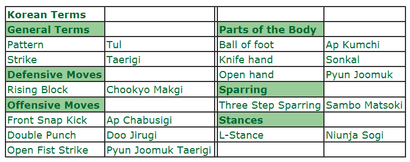Primary Taekwon-Do
Yellow Stripe - 9th Kup
Practical
Sitting stance - double punch x 10, counted in Korean
Press ups x 20, counted in Korean
Walking stance - Low block, rising block x 4, counted in Korean. Fwd + Back
Walking stance - Middle block, reverse punch x 4, counted in Korean. Fwd + Back
Front Kick Double Punch x 4, counted in Korean. Fwd + Back
3 Step Sparring - Numbers 1
Power Test - Side kick using the foot sword, A controlled measure followed by a powerful middle section side kick.
Exercise Sajo Jirugi No. 1
Exercise Sajo Jirugi No. 2
Exercise Sajo Makgi
Pattern - Chon-Ji

Theory
Yellow signifies earth, from which a plant sprouts and takes root, as TaeKwon-Do foundation is being laid.
Chon-Ji literally means ‘Heaven and Earth’. In the Orient it is interpreted as the creation of the world or the beginning of human history, therefore it is the initial pattern played by the beginner. This pattern consist s of two similar parts, one to represent the Heaven and the other the Earth.
1.How many moves in Chon-ji? – 19
2.What is the meaning of Chon-ji? – Chon-Ji literally means ‘Heaven and Earth’. In the Orient it is interpreted as the creation of the world or the beginning of human history, therefore it is the initial pattern played by the beginner. This pattern consists of two similar parts, one to represent the Heaven and the other the Earth.
3.What is front snap kick & side piercing kick in Korean? – Ap Chabusigi (front snap kick) & Yopcha Jirugi (side piercing kick)
4.What part of the foot is used when performing front snap kick and side piercing kick? – Ball of the foot – Ap Kumchi (front kick), Foot sword – Balkal (side kick)
5.What is the Korean for a pattern? – Tul
6.What is the Korean for a Thrust? – Tulgi
7.What does the colour Yellow signify? – Yellow signifies earth, from which a plant sprouts and takes root, as TaeKwon-Do foundation is being laid.
8.What is L-stance in Korean? – Niunja Sogi
9.What is the weight distribution in L-stance & primary leg? – 70 / 30 the back leg is primary due to having most weight on it
10.What is the Korean for 3 step sparring? – Sambo Matsoki
11.Name 3 blocks in Korean? – Najunde Bakat Palmok makgi, Kaunde An palmok Makgi, Najunde Sonkal Makgi and Chookyo Makgi.
12.What is the blocking tool when using Rising block? – The outer forearm
13.Is Rising block performed half or full facing? - Full facing
14.What is the Korean for double punch? – Doo Jirugi
15.When was taekwon-Do introduced to the UK & by Whom? – 1967 by Master Rhee Ki Ha
16.What is the Korean for fore fist & where? – Ap Joomuk
17.What is the Korean for knifehand & where? – Sonkal
18.What is the Korean for Open fist Thrust (from 3 step sparring no.2) & where? – Pyun Joomuk Tulgi
19.One question from previous Gradings! – Remember and know your previous Theory.